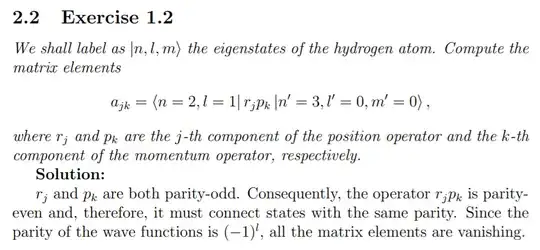I wonder if the problem in the image can be solved with the Wigner-Eckart (W-E) theorem. These elements have to vanish. I tried introducing the identity operator in between $r$ and $p$ to then use the W-E theorem for the new matrix elements. I was hoping that the selection rules for each of the Clebsch-Gordan coefficients wouldn't overlap in the sum, vanishing so the product of the coefficients, but they do. So I guess some of the reduced matrix elements have to vanish, but I'm not sure if those can be solved. Any ideas would be great, if not, I guess it has to be solved with parity analysis. Thank you!
1 Answers
Yes. Since both $\hat{\textbf{r}}$ and $\hat{\textbf{p}}$ are vectors, their product must decompose into a sum of $L_2=2,1$ and $0$ tensors. The $L_2=1$ tensor is antisymmetric and in fact by inspection proportional to $\epsilon_{jki}\hat \ell_i$, (the $i$ component of angular momentum) ; angular momentum operators like $\hat \ell_i$ cannot change $\ell'$ hence the matrix element will be $0$ between $\ell=1$ and $\ell'=0$.
There remains the parts in the product proportional to the $L_2=2$ and $L_2=0$, and these will be proportional to $Y_{2\mu}(\theta,\varphi)$ and $Y_{00}(\theta,\varphi)$ respectively once expressed in spherical coordinates, with $\mu$ depending on the specific $j,k$.
Now the matrix element $\langle 21m\vert r_j p_k\vert 3 0 0\rangle$ will contain an angular integral of
the form
\begin{align}
\int d\Omega Y_{1m}^*(\theta,\varphi) Y_{2\mu}(\theta,\varphi) Y_{00}(\theta,\varphi)
\end{align} or
\begin{align}
\int d\Omega Y_{1m}^*(\theta,\varphi) Y_{00}(\theta,\varphi) Y_{00}(\theta,\varphi)\, .
\end{align}
Both of these are automatically $0$ by orthogonality of the spherical harmonics since, by Gaunt's theorem
\begin{align}
Y_{\ell' m'}(\theta,\varphi)Y_{L_2M_2}(\theta,\varphi)
=\sum_L \sqrt{\frac{(2\ell '+1)(2L_2+1)}{4\pi (2L+1)}} C_{\ell' 0;L_20}^{L0} C_{\ell' m';L_2M_2}^{LM}Y_{LM}
(\theta,\varphi)
\end{align}
will reduce to a factor of $Y_{L_2M_2}(\theta,\varphi)$ since $\ell'=0$. The result at this point is $0$ by orthogonality of the spherical harmonics.
Moreover in general, the Clebsch $C_{\ell'0;L_20}^{L0}$, which would implicitly be included in the reduced matrix element, is $0$ whenever $\ell'+L_2+L$ is odd; is the case at hand with $L_2=0$ or $2$, $\ell'=0$, and $L=\ell=1$, the sum $0+L_2+1$ is necessarily odd . That's the parity argument of the solution.
In addition to this, the angular momenta $0,L_2$ and $1$ are not triangular: because $\ell'=0$, the only possible values of $\ell$ are those of $L_2$, i.e. $2$ or $0$, but $\ell=1$ so the triangularity condition is violated.
- 49,168
- 21
- 71
- 148
